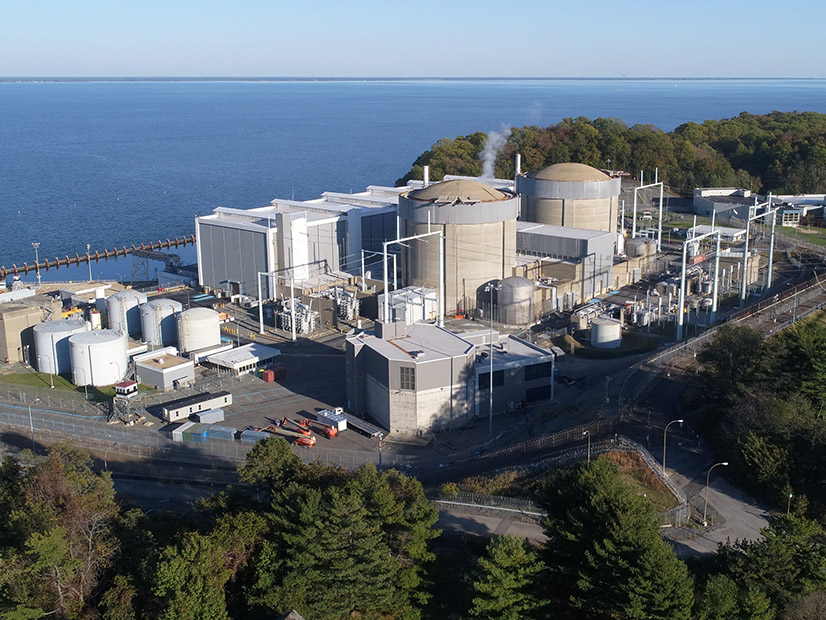Constellation Energy filed a complaint against PJM at FERC on Nov. 22, opening up another regulatory front in the debate over co-locating data centers at existing nuclear plants (EL25-20).
Constellation alleges that PJM’s tariff is unfair because it does not contain rules for interconnected generators to follow when seeking to provide service to fully isolated, co-located load.
The issue already was in front of FERC in other proceedings, with the commission taking a universal look at co-located load in a recent technical conference. (See FERC Dives into Data Center Co-location Debate at Technical Conference.)
Exelon, from which Constellation was spun off, also has pending reforms to its interconnection rules that led to protests from the nuclear plant owner. (See Exelon, Constellation at Loggerheads over Data Center Co-Location.)
“While nothing in the tariff suggests any prohibition of fully isolated co-located load, some local utilities are taking advantage of the lack of tariff rules to thwart competition to serve large end use loads, thereby delaying by several years and significantly increasing costs to serve data centers that are critical to national security, economic development and other national priorities,” Constellation’s complaint said. “This lack of tariff rules is allowing transmission owners across the PJM system to treat generators seeking to serve fully isolated co-located load differently.”
PJM released guidance for the issue in April 2024, which explains how the RTO has been reviewing co-location. The complaint said that should be included in the tariff. FERC might decide that it has to weigh in on other issues, but those could be dealt with in a paper hearing.
The complaint argues that rules are needed so market participants understand what they have to do to enter into generator co-location deals. They also would ensure utilities understand the FERC jurisdictional rules applicable to fully isolated, co-located load and “cease exercising their monopoly power to thwart competition.”
“It is necessary to establish consistency across the PJM footprint and avoid the current circumstance of each of the transmission owners in PJM deciding whether and to what extent they will follow PJM’s guidance,” the complaint said. “Otherwise, we will be left with a mishmash of co-location rules at the federal level that are driven by the self-interests of each of the transmission utilities.”
That mishmash already is starting to happen based on how different Exelon’s pending rules would treat co-located demand compared to how PPL Electric Utilities dealt with the 300-MW data center co-located at the Susquehanna nuclear plant.
Data centers are a national security priority due to the new technologies driving them, such as artificial intelligence. Their increasing size has made them difficult to connect to the grid, as that often requires new transmission. Building out the required lines takes several years and leads to higher costs for other consumers, the complaint said.
“As a matter of simple engineering, it is more efficient to locate large loads next to large generation, when possible,” Constellation said. “One longstanding option that has been available to any load since the beginning of open access has been to connect directly to a generator either fully independent of the network grid or with a reduced reliance on the grid.”
Data centers have pursued contracts for fully isolated, co-located load, “networked co-located load” where they rely partly on the grid and partly on a nearby power plant, and a “networked load” configuration that relies entirely on the grid. The last two have formal rules in PJM’s tariff, but fully isolated co-located load lacks formal rules, with the tariff also saying nothing that indicates the configuration is inconsistent with the RTO’s rules.
The issue of the less formal guidance on co-location came up when FERC recently rejected the expansion of a co-located data center at the Susquehanna nuclear plant. (See FERC Rejects Expansion of Co-located Data Center at Susquehanna Nuclear Plant.) The amendments to the Susquehanna deal were proposed in large part so PJM’s guidance would be binding on the parties.
FERC rejected them in part because it questioned whether the RTO planned to offer interconnection services on equivalent terms to all similarly situated interconnection customers. FERC’s order acknowledged the guidance was “not part of the PJM tariff, has not been approved by the commission and was not before the commission in the instant filing.”
The complaint notes that PJM has completed studies for potential co-located loads at three Constellation generation sites, which indicated none of those would have been able to draw power from the grid.
Exelon reviewed the deal at Constellation’s LaSalle Clean Energy Center in Illinois, but then refused to do so at the other two units, insisting that the generation owner or its customer first must apply for retail service and designate what sort of wholesale transmission service it would take from Exelon. The utility holding company then stopped working with the data center at the LaSalle plant, the complaint said.
Connecting a major data center to the grid can take five to 10 years, and in a global race for new technology, any delay is harmful to the national interest, the complaint said.
“This interconnection delay imposes unquantifiable risks and costs to the national economy and security and advances in AI,” the complaint said. “Each year that hyperscale data centers await interconnection to the grid risks another year of losing ground to competing nations.”



